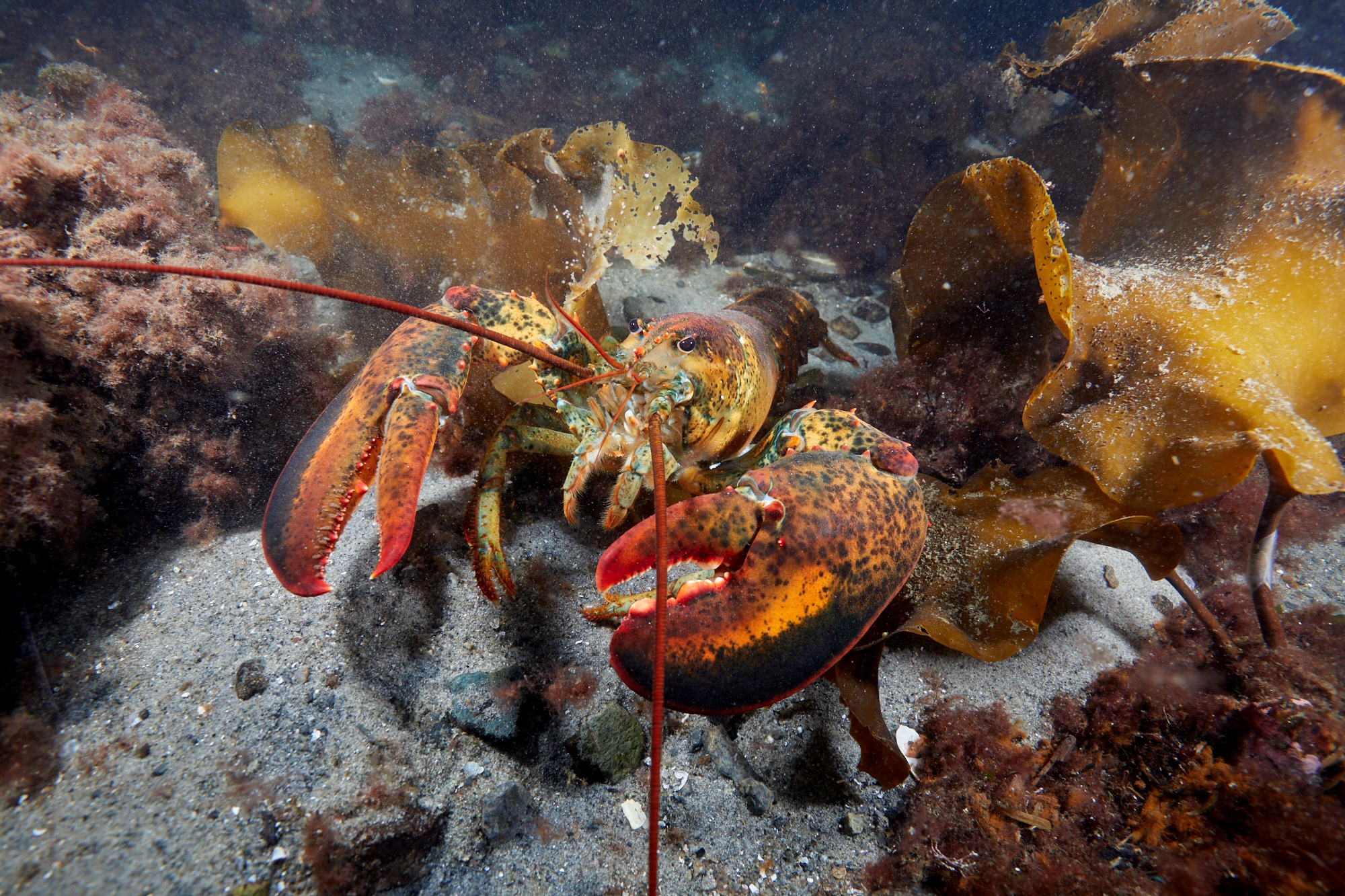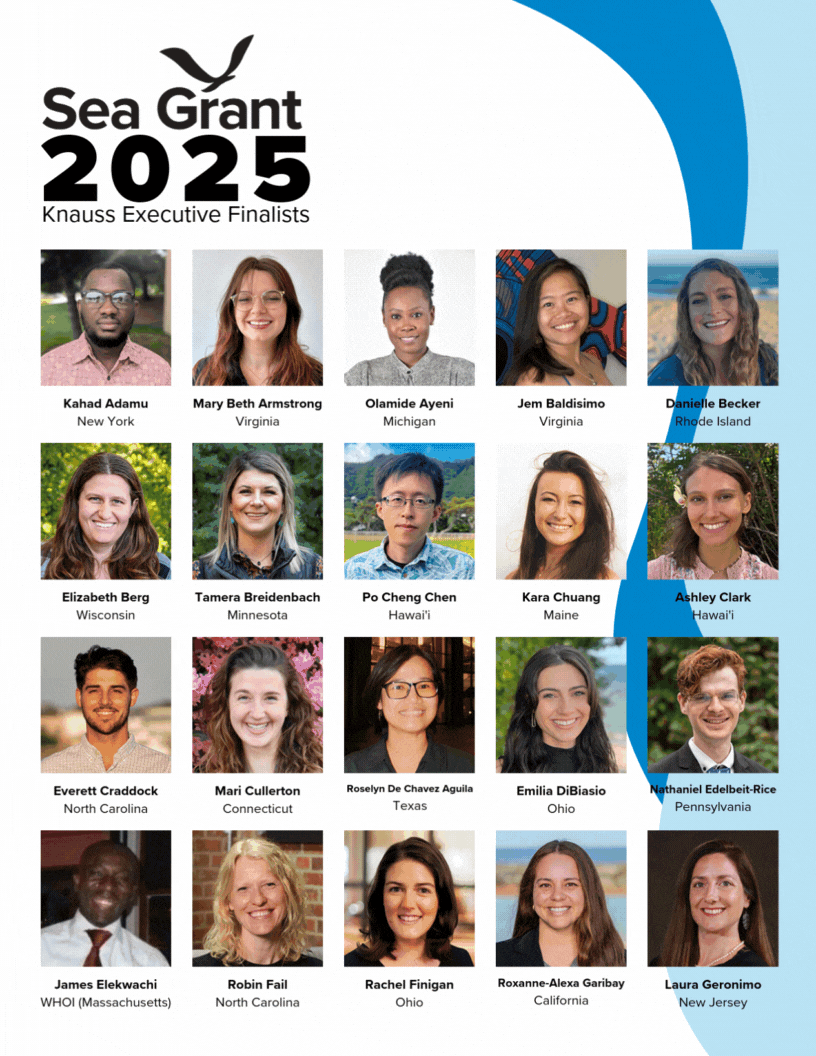Sea Grant announces $2 million in support of the Sea Grant American Lobster Initiative to address scientific and stakeholder needs associated with this important fishery.
The funded research will address critical gaps in knowledge about how American lobster is being impacted by environmental change in the Gulf of Maine, Georges Bank and southern New England. The focus of this research is based on specific language in Sea Grant’s fiscal year 2020 appropriations language.
The nine extramural research projects being funded in 2020 were chosen through a competitive process that included review by subject matter experts. The research competition solicited proposals aimed at addressing one or more of the following priorities:
- Increased understanding of life history parameters, including but not limited to, growth, maturity, and species interactions;
- Larval ecology and early biology;
- Spatial distribution and migration, including but not limited to, habitat and trophic interactions; and
- Socio-ecological investigations to inform future management decisions, including but not limited to, research exploring bait alternatives to herring and their implications for the lobster fishery.
The American lobster (Homarus americanus) is one of the most iconic modern American fisheries, and total U.S. landings of lobster are facing uncertainty after years of increasing landings. The landing value of the American lobster fishery was estimated at $626.7 million in 2019 and represents one of the largest and most valuable fisheries along the Atlantic coast (Souce: NOAA Fisheries). In a 2018 report, lobster was the highest valued species group in the nation.
In fiscal year 2019, the National Sea Grant Office (NSGO) launched the American Lobster Initiative to support two connected efforts, a national research competition and a Northeast Regional Lobster Extension Program. The extension program, designed to work with communities, is a four-year program that links lobster research with stakeholders who need and can use the results–the lobster fishing industry, resource managers, and others across the region. The American Lobster Initiative was informed by listening sessions with regional fishing industry stakeholders, state and federal fisheries managers, and university, state and federal fisheries researchers.
For more information on Sea Grant’s American Lobster Initiative, visit this page.
2020 Selected Research Projects to Advance Understanding of American Lobster
Assessing the broad-scale distribution and abundance of lobster larvae and their potential food sources throughout the Gulf of Maine and Georges Bank
Atlantic Offshore Lobstermen’s Association, PI Henninger
The authors propose a broad-scale survey that investigates the spatial and temporal distribution and abundance of early and late stage lobster larvae and their likely zooplankton prey to investigate factors affecting recruitment in the Gulf of Maine and Georges Bank (GOM/GBK) stock area. This effort will provide a comprehensive snapshot of lobster larvae across the GOM/GBK stock which will help inform biophysical models, provide context to better understand and model the SSB-recruit relationship under the current climate regime, and provide regional data to investigate the role of trophic interactions at the larval stage. Further, the authors propose to test different platforms for field work to inform best practices for future larval surveys. This work will complement ongoing lobster monitoring efforts and make it possible to consider the distribution of all lobster life stages in future management strategies.
Bait alternative development and future visioning in the New England lobster fishery
University of Massachusetts Amherst, PI Jordaan
This work targets the research topic focused on socio-ecological investigations to inform future management decisions by completing research exploring bait alternatives to herring and the implications for the lobster fishery. The research will be focused on the Gulf of Maine (GOM) but with potential to impact any trap fishery in the U.S. Specifically, the authors aim to develop a bait alternative that conforms to state guidelines developed, or being developed, to limit negative impacts of the lobster industry on the Atlantic herring stock, create resilience within the lobster fishery by reducing cost uncertainty, and redirect seafood processing waste streams from local resources into a value added product.
Early life history of American lobsters in coastal southern New England waters
University of Rhode Island, PI Collie
The Southern New England (SNE) lobster stock is currently experiencing recruitment failure, with a population bottleneck occurring somewhere between the egg and juvenile stages. The objective of this project is to measure the abundance and spatial distribution of lobster larvae and post-settlement juveniles in Rhode Island waters to identify where in the life history the recruitment bottleneck occurs. The project components include lobster larvae sampling and temperature profile measurements. Resulting data will be used to test whether lobster recruitment is limited more by pre- or post-settlement processes. The authors will test whether a thermal refuge exists for juvenile lobsters at depths deeper than those that have been historically occupied. Field data will be interpreted in the broader context of circulation patterns and thermal habitat on the SNE continental shelf. A better understanding of the connectivity between egg production, pelagic larvae and benthic young-of-year, and juvenile abundances will provide insight into survival during this critical period of lobster life history. Understanding the processes regulating recruitment and the survival bottleneck is imperative for rebuilding the SNE lobster stock.
Fishing in hot water: defining sentinel indicators of resilience in the American lobster fishery
University of Maine Orono, PI Stoll
The intent of this research is to develop sentinel indicators of resilience for the lobster industry that can be used to detect early signs of vulnerability among harvesters. In pursuit of this research, the authors will use peer-reviewed methods to develop and evaluate sentinel indicators and work closely with the lobster industry, managers and the Lobster Regional Extension Program to solicit input and distribute results. Although the status of the lobster stock is closely monitored in the Gulf of Maine, no indicators currently exist to detect vulnerability among participants in the industry. Understanding vulnerability is vital to informing future management decisions and coastal community resilience.
Incorporating changes in thermal habitat and growth to improve the assessment of American lobster stocks and spatial distribution in the Gulf of Maine, Georges Bank and southern New England
University of Maine Orono, PI Chen
The pinnacle purpose of this project is to develop a modeling framework to assess and forecast spatio-temporal dynamics of American lobster in a changing ecosystem. A forecasting model will be built into the American lobster stock assessment framework that utilizes stock assessment output and projected thermal habitat to predict stock size and catch seasonally. This will allow for simulating multiple future climate scenarios and fishing mortalities in the Gulf of Maine, Georges Bank and southern New England. Additionally, this work will also enable the testing of the UMaine Lobster Stock Assessment model under previously utilized spatial scales from the Atlantic States Marine Fisheries commission to determine if the stock unit assumptions hold true using this stock assessment model. Throughout the testing and application process this work supports the implementation of a grounded outreach plan that will allow for method fluidity due to feedback from American lobster management agencies and stakeholders including state agencies, the Atlantic States Marine Fisheries Commission, NOAA Fisheries and lobster industry.
Surface convergences: a critical pelagic microhabitat for American lobster postlarvae?
Woods Hole Oceanographic Institution, PI Pineda
The few studies that have noticed the occurrence of American lobster postlarvae in surface convergences suggest that these features could be critical for the ecology and population dynamics of this species. Here, the authors propose: (a) To elucidate the main pelagic habitat of American lobster postlarvae, including open unstructured waters and different types of surface convergences (e.g., hydrographic fronts, nonlinear internal waves and Langmuir cells), (b) to resolve whether postlarvae aggregate differentially in hydrographic or non-hydrographic convergences (e.g., tidal fronts or Langmuir cells), (c) to evaluate the type and variability of convergences that occur in the Gulf of Maine and to describe their environmental variability, including circulation and hydrographic structure, and (e) to test whether postlarvae in convergences (hydrographic or non-hydrographic) are in better condition than postlarvae in open, unstructured waters. This study will be one of the first to address the microhabitat of postlarvae and the microhabitat properties that may enhance their survivorship, a critical link in determining the population dynamics of the American lobster.
Testing and developing effective non-invasive female maturity assessment methods and protocols for the American lobster (Homarus americanus)
Maine Department of Marine Resources, PI Waller
The Maine Department of Marine Resources (MEDMR) began conducting female American lobster maturity studies via ovarian staging, widely recognized as the most accurate maturity assessment methodology, although time and resource-intensive, in 2018. The goal of the work proposed here is to leverage MEDMR’s recent efforts in order to evaluate and develop two promising non-invasive maturity assessment methodologies and generate publicly accessible instructional materials that would allow for lobster maturity datasets to be easily updated in the future. The authors will build upon three years of female lobster maturity research by the MEDMR by analyzing samples collected through these recent works to test the effectiveness of these methodologies on females from across the Gulf of Maine. This research team represents a new collaboration of state agency researchers, members of the lobster industry, an industry trade association and Canadian researchers all invested in the continued success of the American lobster fishery and eager to contribute to the National Sea Grant American Lobster Initiative. The research proposed here will provide insight into the most appropriate maturity assessment approach and provide long-term benefits to researchers who can utilize these methods to update size at maturity datasets regularly as conditions in the Gulf of Maine continue to change.
Understanding and improving spatial distribution projections for lobster: Considering predation and building expert consensus
Gulf of Maine Research Institute, PI Mills
In this project, the authors aim to address the limitations of lobster distribution models and strengthen stakeholders’ trust in our ability to accurately quantify, project, explain and apply lobster distribution and abundance models under future climate conditions. The authors will advance lobster distribution models by graduating from traditional single species, single life stage, “environment-only” models to a joint species distribution model, which accounts for juvenile and adult life stages, environmental conditions, trophic interactions and unmeasured spatial and spatio-temporal variability. Second, they will use the joint species distribution model to generate future projections of juvenile and adult lobster distribution and abundance, which incorporate both changing environmental conditions and the spatial distribution and abundance of lobster predators. Finally, they will lead a working group composed of other experts and stakeholders to discuss modeling differences, diagnose key sources of uncertainty, and guide future model development and output application efforts. In sum, this research will provide information necessary to support forward-looking conservation and management strategies for the lobster fishery, ultimately enhancing the resilience and adaptation capacity of coastal communities that rely on lobster to support their livelihoods and maintain their cultural identity.
Understanding the cause of low dissolved oxygen in Cape Cod Bay and initiating a hypoxia warning system for the lobster fishery
Massachusetts Department of Fish and Game, PI Pugh
The authors propose to develop a comprehensive understanding of the conditions that resulted in the 2019 hypoxic event in southern Cape Cod Bay (CCB) and to improve the ability to forecast such conditions. The goal is to be able to predict the onset of hypoxia in CCB, allowing researchers to alert the commercial lobster fleet and other stakeholders of changing conditions. This will enable fishers to make critical real-time decisions regarding their fishing operations. The authors will also establish a real-time telemetered buoy that continuously measures bottom oxygen concentration during the summer and early fall. The buoy will be complemented by weekly high-resolution sampling to characterize the spatial distribution of bottom oxygen and water quality parameters throughout Cape Cod Bay. Together, these data will serve as an early warning system for the lobster fleet to warn of conditions when bottom oxygen levels may become lethal.


